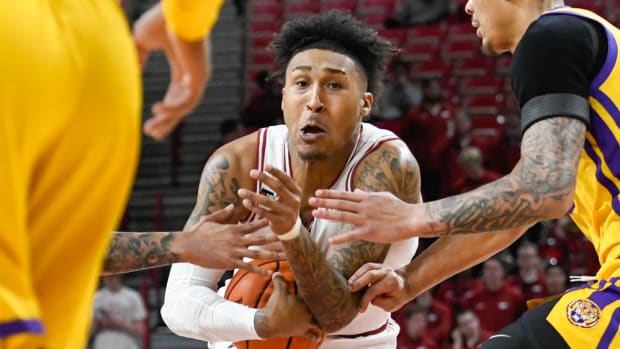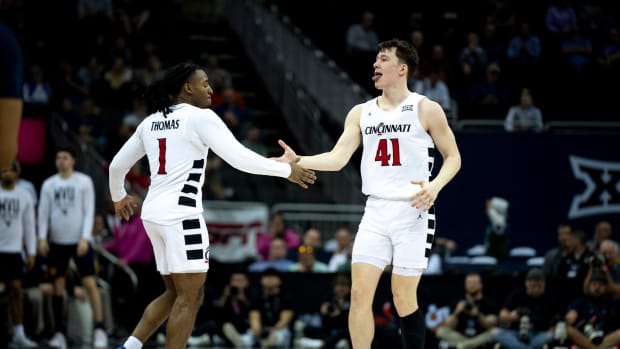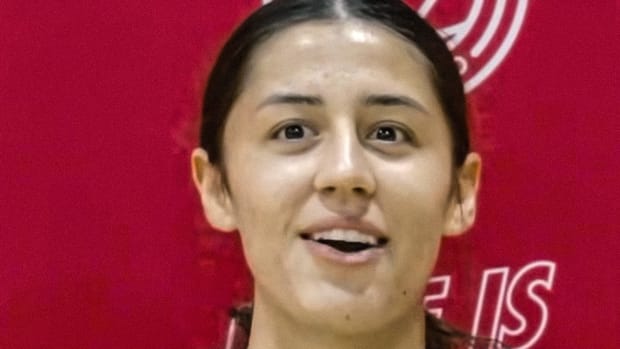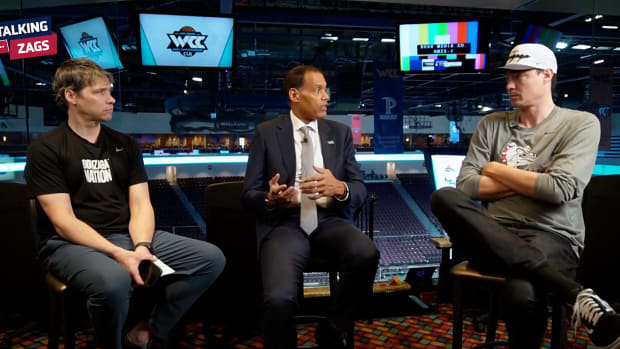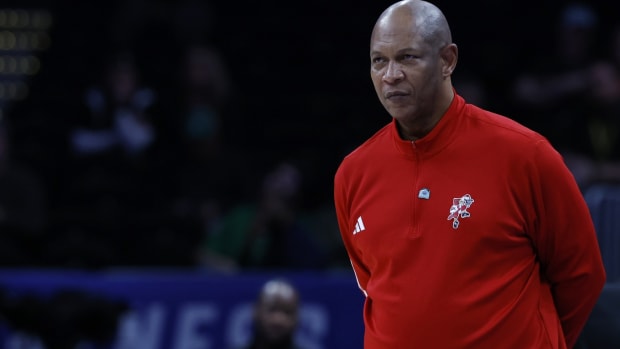The Magic Eight: One of These Teams Will Win the 2022 Men’s NCAA Tournament
Welcome back to Sports Illustrated’s Magic Eight! With 25 days until Selection Sunday, it’s time to lock in some picks for what will happen once the calendar flips to March. The annual goal of the Magic Eight is simple: Identify the eight teams that can win the national championship and separate the contenders from the pretenders in the process.
My colleague Molly Geary did an admirable job last season. Among her Magic Eight were three of the four Final Four teams (including champion Baylor and runner-up Gonzaga), while just one of her “notable omissions” even reached the Elite Eight.
And in case you’re new to the Magic Eight, there are some rules. At least one of the eight has to come from outside the top 15 of the current AP poll and two have to come from outside the top eight in the poll. That means some tough cuts! Here’s who made my cut and who came up just short.

Kentucky’s Oscar Tshiebwe; Duke’s Paolo Banchero; Texas Tech's Kevin McCullar.
Scott Utterback/Courier Journal/USA TODAY Network; Dawson Powers; Rob Ferguson/USA TODAY Sports
All stats and rankings are as of Tuesday, Feb. 15, 2022.
Gonzaga (21–2, 10–0 WCC)
It should be no surprise that the sport’s most consistently dominant program of late makes the cut—in fact, the Bulldogs have been among SI’s Magic Eight every season since 2016–17. And while the narrative nationally is that there’s no single team that clearly stands above the rest in college hoops right now, the gap between the Zags’ KenPom adjusted efficiency margin and No. 2 Arizona’s (+4.95) is larger than the gap between Arizona and No. 10 UCLA. While my personal eye test doesn’t see that wide a gap, Gonzaga has been out-of-this-world good since a COVID-19 pause around New Year’s that coincided with the start of league play. Just two teams have played it within 20 points in that stretch (San Francisco and Saint Mary’s both lost by 16), impressive consistency regardless of the quality of the opponent).
The biggest differentiator with this Gonzaga team compared to last year’s is defense, particularly on the interior. Freshman Chet Holmgren’s rim-protecting ability has changed the game for teams trying to attack the basket against the Zags, as they rank third in the country (per KenPom) in two-point field goal percentage defense. A look at the on-off numbers truly illustrates Holmgren’s impact: Per Hoop-Explorer, teams shoot 47.8% at the rim when Holmgren’s in the game compared to 55.5% when he’s off the floor.
Adding this defensive strength to Gonzaga’s elite offense that ranks tops nationally in effective field goal percentage makes the Bulldogs the most complete team in the sport. They have a go-to scorer on the block in Drew Timme, a steady point guard who makes great decisions in Andrew Nembhard and they surround that duo with guys who can all knock down threes in bunches.
The lone concern with Gonzaga is how it deals with teams with elite athleticism. They looked overwhelmed by Baylor’s athleticism in last year’s national title game, and the feeling was similar in November when Duke took them down in Las Vegas. Could that come back to bite the Zags again in March against a team such as Duke or Arizona?
Auburn (23–2, 11–1 SEC)
There’s no doubt that Auburn has elite personnel. That starts with arguably the best frontcourt pairing in the sport in Walker Kessler and Jabari Smith. For the modern game, it’s about as good a duo as you could possibly ask for. Kessler has elite length and rim-protecting instincts, which has transformed the Auburn defense. He’s also a great lob-catcher on offense and can occasionally stretch the defense from deep. Smith is a generationally good shooter, capable of elevating over just about anyone thanks to his height, long arms and high release point.
Bruce Pearl surrounds that dynamic duo with athletic, competitive players who can handle the ball and defend. K.D. Johnson is as emotional a player as there is in the sport, but Pearl has been able to get Johnson to channel that energy positively. He’s a relentless driver downhill and can go on tears from deep. And while most elite teams have one great point guard, Pearl has a pair that complement each other well. Zep Jasper is a game manager, a steady hand on both ends who doesn’t make mistakes and can make open shots in the flow of the offense. Wendell Green Jr. is the opposite, a dynamic playmaker with a flair for the dramatic who occasionally makes a boneheaded play. That PG dynamic will be a fascinating one to watch in March—will Pearl look for more explosiveness from Green or turn to the level-headed Jasper?
Arizona (22–2, 12–1 Pac-12)
A coach who played the Wildcats earlier this season told me Arizona plays with the X’s and O’s of Gonzaga and the talent of Duke or Kentucky. Hoop Vision’s Jordan Sperber did a great breakdown of some of the schematic similarities to the Zags early in the season, and most of this still rings true. The Wildcats fly up and down the court, can crush you on the offensive glass and dominate the paint because of Christian Koloko’s presence protecting the rim. Plus, they have a future NBA lottery pick in Bennedict Mathurin, who can be one of the more explosive scorers in the sport when he’s rolling.
All of this is why the Wildcats have moments when they look utterly unstoppable. Take Saturday’s win at Washington, in which Arizona dug itself an early 25–11 deficit before going on 24–4 and 13–2 runs in the next 15 minutes of game action to take control. To lead by 28 by the middle of the second half of a game, you trailed by 14 in after 10 minutes is a perfect encapsulation of why this team belongs in the Magic Eight. It’s simply too explosive not to be considered among the top contenders to cut down the nets in New Orleans.
The only thing that concerns me with the Wildcats is the volatility of point guard Kerr Kriisa. The sophomore is an emotional player who, at times, has been outstanding for coach Tommy Lloyd in solidifying the position. At other times, he has had the tendency to shoot Arizona out of games. His 0-for-12 performance against UCLA in January was the most telling example of this, but he didn’t play well in the Wildcats’ lone other loss to Tennessee. I wish Arizona had a more steady point guard—if it did, it might be my pick to win it all.
Kentucky (21–5, 10–3 SEC)
What stands out most about the Wildcats right now is their role allocation. Kentucky has been unbelievably impressive since mid-December. The team has just three losses in that stretch, all on the road against top-20 KenPom teams. And in all three games, one of the UK’s top guards missed a significant portion of the action due to injury. When everyone is on the floor and healthy, Kentucky checks every box. It has the dominating force on the interior in Oscar Tshiebwe, who almost single-handedly has made the Wildcats one of the best rebounding teams in the sport. Sahvir Wheeler and TyTy Washington Jr. are both dynamic with the ball in their hands. Kellan Grady is perhaps the nation’s best outside shooter and Keion Brooks Jr. is a steady glue guy.
Beyond earning the Wildcats extra possessions, Tshiebwe’s dominance on the glass has downstream implications for everything else Kentucky does. Kentucky has to commit fewer numbers to the boards, which means more time to set its defense on one end and more opportunities to leak out and push in transition on the other. And given how good Wheeler is in the open court, good luck stopping Kentucky once it gets out and runs. The combination of talent and cohesion that UK has right now should be a scary sight to the rest of the country.
Baylor (21–4, 9–3 Big 12)
From a 15–0 start to surprising home losses to an injury-plagued Big 12 season, it has been a weird year for the defending national champions. Still, the Bears belong among the nation’s top contenders to cut down the nets in New Orleans. Why?
To me, it starts with point guard play. So many of the best teams in the sport this season don’t have a high-level lead guard. The Bears do have one in James Akinjo, who, when healthy, has been about as good as Scott Drew could have hoped when he added the Arizona transfer to help replace Davion Mitchell and Jared Butler. Akinjo’s not a future NBA player, but he gives the Bears’ offense a level of dynamism and shot creation that other elite teams lack. Add in the fact that LJ Cryer and Adam Flagler are high-level shooters next to him, and the Bears have a backcourt good enough to win you games in March.
Baylor is longer and more athletic than it was last season. That’s due to the additions of freshmen Kendall Brown and Jeremy Sochan, who will both likely be first-round picks. They’re both perfect in the Bears’ scrambling no-middle defense because they can guard multiple positions and block shots. Sochan might be Baylor’s x-factor, especially after center Jonathan Tchamwa Tchatchoua went down with a season-ending injury against Texas earlier this month. Sochan will now get looks as a small-ball center behind starter Flo Thamba, which has a chance to be a really difficult lineup for opponents to guard given Sochan can handle the ball and shoot. But Tchamwa Tchatchoua was huge as a leader and an organizer on defense—can Sochan defend the five spot well enough for JTT’s absence to not be felt as strongly?
No team has repeated as champs since Billy Donovan’s Florida teams in 2006 and ’07. The Bears aren’t the favorite to cut down the nets, and certainly have some work to do reinventing themselves after losing Tchamwa Tchatchoua. But never count a Scott Drew team out, especially with as much talent as Baylor has.
Duke (22–4, 12–3 ACC)
Duke’s ceiling is the highest in the sport. At its best, Duke has four players on the floor who can initiate in ball screens and guard multiple positions on the defensive end at any given time. The Blue Devils’ size, athleticism and talent level can overwhelm even the best teams. They have a pro-level scorer in Paolo Banchero capable of carrying a team down the stretch, and fellow freshman AJ Griffin has emerged as a potent second option after being brought along slowly due to an offseason knee injury. If you’re looking to bet on talent, no team has more of it than the Dukies.
At times this season, it has felt like Duke has been on cruise control. Perhaps that’s because this year’s weak ACC hasn’t required the Devils to play their best basketball to win. But when Duke has been its most engaged self on the defensive end, it’s really hard to score on it. Mark Williams and Theo John are old-fashioned enforcers at the rim, matching elite physicality with great length and shot-blocking instincts. The switchability of Duke’s wings makes it hard to exploit mismatches, and for a young team Duke is remarkably good at defending without fouling. That’s a trait that should serve it well come March.
Plus, it helps to have a coach who has been in Final Fours and national title games before. Mike Krzyzewski certainly fits that bill. In many ways, this Duke team reminds me, in makeup, of K’s last championship team in 2015. Like that group, this one has elite talent but a great mix of more experienced players and one-and-done freshmen. It’s a scary combination for the rest of the sport.
Texas Tech (19–6, 8–4 Big 12)
This pick might surprise you, particularly given that it comes at the expense of Kansas (who I’ll discuss later). But per T-Rank, since Jan. 1, Texas Tech has been the No. 7 team in the country (and tops in the Big 12). It feels risky to bet on a first-year head coach, but remember: Mark Adams was the right-hand man to Chris Beard when Tech came so painstakingly close to a national title in 2019, so he has been there before.
The big selling point with the Red Raiders is their elite defense. Adams’s no-middle scheme makes even the best offenses uncomfortable, making it nearly impossible to score in the paint against them despite TTU not having an elite rim protector at the back end. The Red Raiders have length and athleticism at every position and a roster completely bought into defending at the highest level. Some teams get their energy on defense from shots falling on the offensive end—Texas Tech gets its offensive energy from getting stops on defense.
Tech’s offense has also been, for the most part, better than expected without a true point guard on the roster. Particularly with Terrence Shannon Jr. in and out of the lineup all season with nagging injuries, Tech hasn’t had a true go-to guy. Instead, any given night a new Red Raider has stepped up. Adonis Arms had his moment in TTU’s road win at Baylor. Big man Bryson Williams dominated in two games against Kansas. Davion Warren and Kevin McCullar have had their moments. Kevin Obanor was one of the stars of March last season when he was at Oral Roberts. Having so many guys who can win you a game is a strong recipe for March.
Ohio State (16–6, 9–4 Big Ten)
The Magic Eight requires a sleeper of sorts, and I think if you’re looking for a team outside the AP top 15 that could make a serious run at a title, it’s Ohio State. Why? It has one of the three best players in the sport in E.J. Liddell, an emerging star freshman in Malaki Branham and experienced role players around them.
Liddell experienced the pain of a first-round upset last season. Despite his 23 points, 14 rebounds and five assists, OSU fell to Oral Roberts, and it seemed like Liddell ran out of gas late in that game. He’s a different player this season, better as a shooter and ballhandler, quicker to defend smaller guards on the perimeter while still strong enough to bang in the post with big men. For a while, the Buckeyes looked like a team with no “Robin” to Liddell’s “Batman,” but Branham has emerged recently as one of the best young guards in the sport. He can really score the ball at all three levels and has made clutch shots for the Buckeyes in conference play.
The other reason to take a flyer on the Buckeyes is the potential return of Justice Sueing. The senior wing has missed all but two games this season with an abdominal issue but is getting closer to returning to the team. Sueing was widely considered OSU’s second-best player coming into the season, an excellent defender with playmaking skills and the ability to knock down jumpers. A Sueing return, even at less than 100%, could give this team the defensive jolt it needs to take the next step into contender status.
Notable Omissions
Purdue (22–4, 11–4 Big Ten)
The Boilermakers aren’t good enough on defense to win a national championship. Purdue has the nation’s No. 116 adjusted defense, per KenPom. For reference, no other team in the top 15 of KenPom’s rankings has a defense ranked worse than No. 37. And according to T-Rank’s “Similar Profiles” tool, the 10 teams with the most similar statistical profiles to the Boilermakers have all failed to make the Final Four, while two of the 10 comparisons were No. 2 seeds that were bounced in the first round of the dance by No. 15’s. I don’t think Purdue is going to suffer that same fate (Zach Edey is just too hard for a mid-major to guard), but the numbers don’t lie—it would take something unprecedented for a team this bad on one side of the ball to win a national title.
Kansas (21–4, 10–2 Big 12)
I’d imagine the Jayhawks will be considered my biggest “snub” on this list. And on paper, they have a lot of the pieces you want in a championship team. They’ve got a true star in Ochai Agbaji, a capable second option in Christian Braun and an offense that ranks in the top five nationally, per KenPom. They have a championship-winning coach in Bill Self. Plus, they sit atop the standings in the best conference in college basketball.
The point guard play is a concern, though. Remy Martin has mostly been a nonfactor in Lawrence and is working his way back from injury. Dajuan Harris Jr. is a great glue guy, but I’m not sure he’s the guy you want running your team in the biggest moments. Add in inconsistency at the center position from senior David McCormack, and it’s just hard for me to see the Jayhawks going on a run to the title.
Providence (21–3, 11–2 Big East)
Yes, the Friars are currently on top of the Big East, and Ed Cooley deserves immense credit for that fact. But does anyone really believe Providence has enough talent to seriously contend for a national title? Al Durham and Jared Bynum are nice players, but that’s not a Final Four backcourt. Eventually, the clock will strike midnight on the Friars’ close game magic.
Villanova (20–6, 13–3 Big East)
It’s hard to forget how overwhelmed Villanova looked athletically by Baylor when the teams met in the nonconference. That look would probably be similar against a team such as Auburn, Arizona or Duke. The Wildcats are extremely disciplined, excellent at shooting the ball and have an elite coach. But do they have the difference-makers athletically to cut down the nets? I’m skeptical. One thing that works in their favor is they are deeper than they were when they lost big games earlier in the season thanks to the emergence of Jordan Longino and getting Bryan Antoine healthy.
Watch college basketball games online all season long with fuboTV: Start with a 7-day free trial!
UCLA (17–5, 9–4 Pac-12)
Maybe this is recency bias with the Bruins having lost three of four, but I’m just not sure UCLA does anything at an elite enough level to win a national championship. It’s efficient on offense, but reliant on Johnny Juzang and Tyger Campbell to hit a lot of tough shots. It’s steady but not spectacular on defense. It doesn’t torch the nets from three or protect the rim or pound you on the glass at elite rates. The Bruins are just solid. Will UCLA’s experience last March help it? Without question. But it’s really hard to find that March hot streak in back-to-back years.
Houston (20–4, 9–2 AAC)
The advanced metrics love the Cougars, but last week’s losses to SMU and Memphis proved what I was pretty sure of for the last six weeks—Houston isn’t good enough to go back to the Final Four without Marcus Sasser or Tramon Mark. After the season-ending injuries to that backcourt duo, Houston lacks the explosive playmaking skill necessary to win big games. The Cougars are extremely well coached, play incredibly hard and are so good on the glass. But when it gets to winning time against another elite team, I just don’t think there’s enough talent. If Sasser hadn’t gone down, it might be a different story.
Illinois (18–6, 11–3 Big Ten)
I may regret leaving the Illini out. They can light it up from three, have the most imposing player in the sport in Kofi Cockburn and have a major x-factor who is finally healthy in Andre Curbelo. But their talent level isn’t overwhelming, and we saw in last year’s tournament that the wrong matchup can exploit Cockburn’s weaknesses and cause problems for this team. Plus, more Curbelo might not be a good thing, given how volatile the sophomore guard has been when on the floor this season.
More College Basketball Coverage:
• Coach K, the Ultimate Team Builder
• Forde Minutes: The Year of the Mid-Major?
• Kofi Cockburn Has Illinois Aiming High
Sports Illustrated may receive compensation for some links to products and services on this website.














